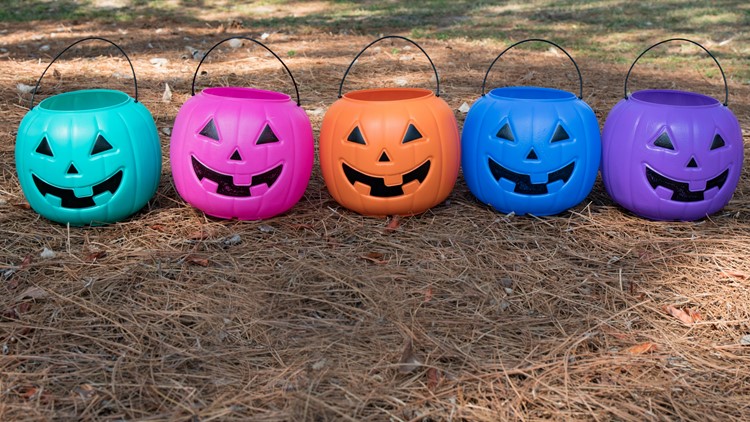Lifestyle
Discover the Meaning Behind Colorful Pumpkins This Halloween

As Halloween approaches, many homes will display a variety of pumpkins, each color representing a different cause. This year, trick-or-treaters may notice teal, purple, blue, and white pumpkins, all aiming to raise awareness for various health issues. Understanding the significance of these colors can enhance the Halloween experience, especially for families navigating food allergies or other conditions.
Teal Pumpkins Promote Allergy Awareness
The presence of a teal pumpkin outside a home signals that the property owner is participating in the Teal Pumpkin Project. This initiative began in East Tennessee, focusing on making trick-or-treating safer and more inclusive for children with food allergies. According to Food Allergy Research and Education, approximately 1 in 13 children has a food allergy.
Homes with teal pumpkins typically offer non-food treats, allowing children with allergies to partake in the festivities without fear of allergic reactions. This simple gesture promotes understanding and acceptance, ensuring that Halloween remains enjoyable for all.
Purple Pumpkins Raise Epilepsy Awareness
Another color gaining attention is purple, associated with the Purple Pumpkin Project. This project was initiated in 2012 by a father in Connecticut who sought to raise awareness about epilepsy following his son’s diagnosis. Displaying a purple pumpkin can indicate that someone in the household is affected by epilepsy or wishes to support others living with the condition.
According to the Epilepsy Foundation, more than 3.4 million people in the United States live with epilepsy, making this initiative crucial for fostering awareness and understanding of the challenges faced by these individuals.
Blue Pumpkins Highlight Autism and Sensory Disorders
Blue pumpkins or blue pumpkin buckets serve as a sign that a child may have autism or a sensory processing disorder. While this initiative does not belong to any official organization, it has become a grassroots effort to promote awareness about autism. The use of blue pumpkins encourages mindfulness among trick-or-treaters and their families.
It is essential to recognize that children with autism or sensory processing disorders may be non-verbal and could have unique sensitivities to costumes and decorations. By displaying blue pumpkins, families can help create a more accommodating environment during Halloween.
White Pumpkins Commemorate Pregnancy and Infant Loss
In addition to the vibrant colors associated with health awareness, white pumpkins carry a poignant message. These pumpkins symbolize remembrance and are displayed by families who have experienced miscarriage, stillbirth, or infant death. October is recognized as Pregnancy and Infant Loss Awareness Month, as highlighted by the March of Dimes.
The White Pumpkin Project began in 2018, initiated by Jennifer Giles, a mother who wrote a poem titled “The White Pumpkin” following her own loss. Families display white pumpkins as a visible means of honoring their babies and fostering conversation about pregnancy and infant loss.
This Halloween, as children navigate their neighborhoods collecting candy, the sight of these colorful pumpkins offers a chance for reflection and understanding. The diverse meanings behind each pumpkin color contribute to a more inclusive and compassionate celebration of the holiday.
-

 Business2 weeks ago
Business2 weeks agoIconic Sand Dollar Social Club Listed for $3 Million in Folly Beach
-

 Politics2 weeks ago
Politics2 weeks agoAfghan Refugee Detained by ICE After Asylum Hearing in New York
-

 Health2 weeks ago
Health2 weeks agoPeptilogics Secures $78 Million to Combat Prosthetic Joint Infections
-

 Science2 weeks ago
Science2 weeks agoResearchers Achieve Fastest Genome Sequencing in Under Four Hours
-

 Lifestyle2 weeks ago
Lifestyle2 weeks agoJump for Good: San Clemente Pier Fundraiser Allows Legal Leaps
-

 Health2 weeks ago
Health2 weeks agoResearcher Uncovers Zika Virus Pathway to Placenta Using Nanotubes
-

 World2 weeks ago
World2 weeks agoUS Passport Ranks Drop Out of Top 10 for First Time Ever
-

 Business2 weeks ago
Business2 weeks agoSan Jose High-Rise Faces Foreclosure Over $182.5 Million Loan
-

 Science2 weeks ago
Science2 weeks agoMars Observed: Detailed Imaging Reveals Dust Avalanche Dynamics
-

 Entertainment2 weeks ago
Entertainment2 weeks agoJennifer Lopez Addresses A-Rod Split in Candid Interview
-

 Top Stories2 weeks ago
Top Stories2 weeks agoChicago Symphony Orchestra Dazzles with Berlioz Under Mäkelä
-

 World2 weeks ago
World2 weeks agoRegional Pilots’ Salaries Surge to Six Figures in 2025









